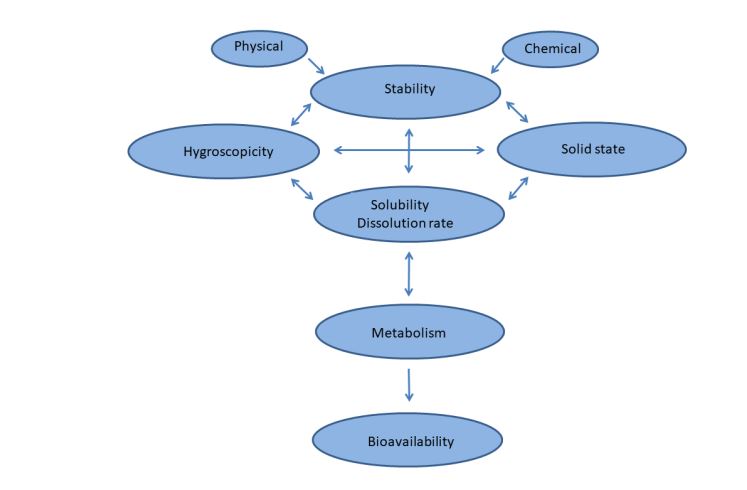Preparation of cocrystal-in-excipient systems by advanced pharmaceutical methods

This thesis has focused on the study of pharmaceutical cocrystal production, and the impact of introducing an excipient into the manufacturing process. Cocrystals of sulfadimidine (SDM) and 4-aminosalicylic acid (4ASA) were formed in the presence of an excipient by spray drying and spray coating, while cocrystals of ibuprofen (IBU) and isonicotinamide (INA) were formed by spray drying and hot melt extrusion.
Cocrystals of SDM and 4ASA were formed in the presence of a number of excipients. The Hansen Solubility Parameter (HSP) of the cocrystal and excipients was calculated. Cocrystal formation was preserved when the API and coformer was co-spray dried in the presence of four excipients at excipient loadings of 50 %. These excipients (inulin, microcrystalline cellulose (MCC), dextran and mannitol), were determined to be immiscible with the cocrystal, based on HSP values, with the difference between the HSP of cocrystal and excipient being at least 9.6 MPa0.5 in all cases. Excipients which were miscible with the cocrystal, based on the differences in HSP values (Soluplus, PVP K15 and HPMC), resulted in the formation of an amorphous solid dispersion at excipient loadings of 50 %.
However, it was determined that cocrystal-in-excipient matrix systems could be formed with two of these excipients when the excipient loading was decreased. Excipients that showed partial miscibility with the cocrystal (polyvinyl alcohol, glycine) resulted in a cocrystal-in-excipient matrix, with single component crystals of API and conformer also present. The experimental solubility of the cocrystal in amorphous excipients was determined, and a simple equation was proposed to predict whether cocrystal formation would be retained in the presence of an excipient, based on the difference in HSP between the cocrystal and excipient, the experimental solubility, and the percentage of excipient to be incorporated into the spray drying process.
Co-spray drying the API and coformer in the presence of two excipients (inulin, MCC) was also investigated. Different excipient loadings and ratios of inulin:MCC were incorporated into the spray drying process. In all cases, cocrystal formation was preserved. The co-spray dried powders were found to be poorly flowable, with a Carr’s index > 25 for all formulations investigated. The powders were subsequently tabletted, with higher excipient loadings resulting in a higher tensile strength of the tablets formed.
Spray drying was compared to hot melt extrusion in the formation of cocrystal-in- excipient matrix systems. Due to the thermal instability of 4ASA, the model cocrystal chosen was IBU:INA, which was processed by spray drying and hot melt extrusion in the presence of a number of excipients. Mannitol, Soluplus and PVP K15 were chosen as excipients which were processed with the API and coformer by spray drying. Xylitol, Soluplus and PVP K15 were chosen as excipients for the extrusion studies. Cocrystal formation was seen in the presence of mannitol by spray drying with up to 50 % excipient loadings, while cocrystal formation was only seen when no more than 10 % PVP K15 and Soluplus were incorporated into the process. This can be explained by the differences in HSP between the cocrystal and excipients. Mannitol is immiscible with the cocrystal with a difference in HSP of 18.3 MPa0.5, while the difference in HSP between the cocrystal and excipient is 2.1 and 1.6 MPa0.5 for Soluplus and PVP K15 respectively.
Different results were observed for the hot melt extruded formulations. Cocrystal formation was seen only at low xylitol loading (10 %), despite a large difference in HSP between the cocrystal and excipient (20.7 MPa0.5). Cocrystal formation, as well as the presence of individual API and coformer, was observed when PVP K15 and Soluplus were incorporated into the extrusion process at 10 % excipient loading. Therefore, spray drying may be considered a more feasible method to produce cocrystal-in-excipient systems. The greater molecular mobility of the API and coformer in solution during the spray drying process, relative to the presumed lower molecular mobility during hot melt extrusion, may allow higher excipient loads to be incorporated into the process while still retaining cocrystal structure.
Spray coating was successfully employed as a method to produce a layer of cocrystals on the surface of inert beads. Both formulation and process parameters were optimised to produce cocrystal coated beads. The spray rate of the solution onto the beads and the total amount of mass sprayed had a positive effect on the degree of crystallinity and the loading efficiency, while the nitrogen airflow and atomisation pressure had a negative impact on the loading efficiency. In addition, the atomisation pressure promoted attrition of the beads.
Flow studies of the coated and uncoated beads were performed. The cocrystal coated beads demonstrated improved flow properties, suggesting that the cocrystal beads may be amenable to downstream processes such as capsule filling. In addition, a faster release of SDM from the cocrystal coated beads compared to the spray dried cocrystal was observed. In previous studies, during dissolution, the spray dried cocrystal was observed to agglomerate, reducing the dissolution rate of the spray dried cocrystal compared to the cocrystal produced by different crystallisation methods. However, due to the large particle size of the sugar beads, agglomeration does not occur, thereby increasing the surface area available from which dissolution can occur.
Based on the results from the studies in this thesis, it appears that cocrystallisation can occur in the presence of an excipient when the method of cocrystal formation is mediated by the amorphous state. The process itself (spray drying, hot melt extrusion, spray coating) and associated process and formulation parameters may dictate the excipient loading that can be incorporated into the process without impeding cocrystal formation. Download the thesis of David Walsh here: preparation-of-cocrystal-in-excipient-systems-by-advanced-pharmaceutical-methods.pdf
A thesis submitted for the degree of Doctor of Philosophy
at the School of Pharmacy and Pharmaceutical Sciences Trinity College Dublin, The University of Dublin Ireland
by David Walsh BPharm, MPharm, M.P.S.I.
under the direction and supervision of Professor Anne Marie Healy B.Sc. (Pharm), PhD, M.P.S.I., F.T.C.D.
March 2019 – http://www.tara.tcd.ie/bitstream/handle/2262/86180/DW%20Thesis_corrections_April.pdf?sequence=1

